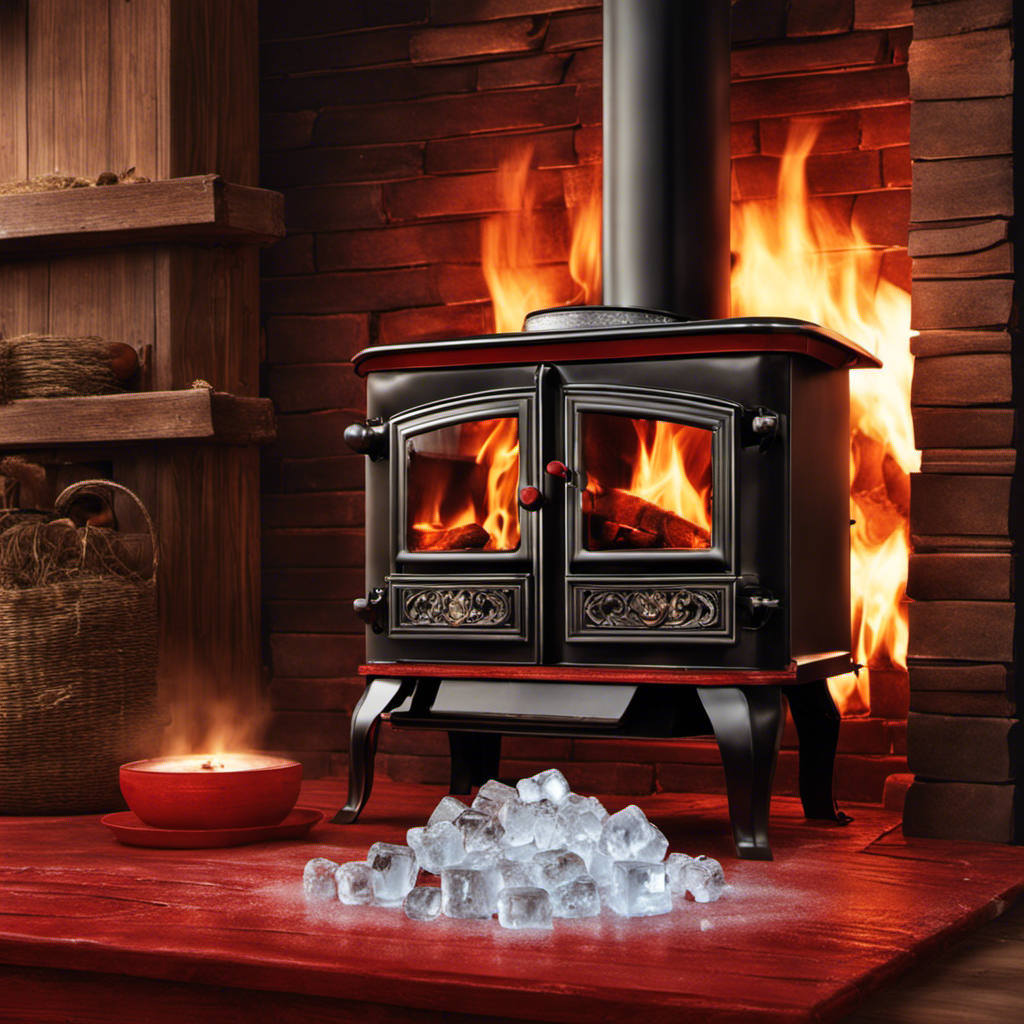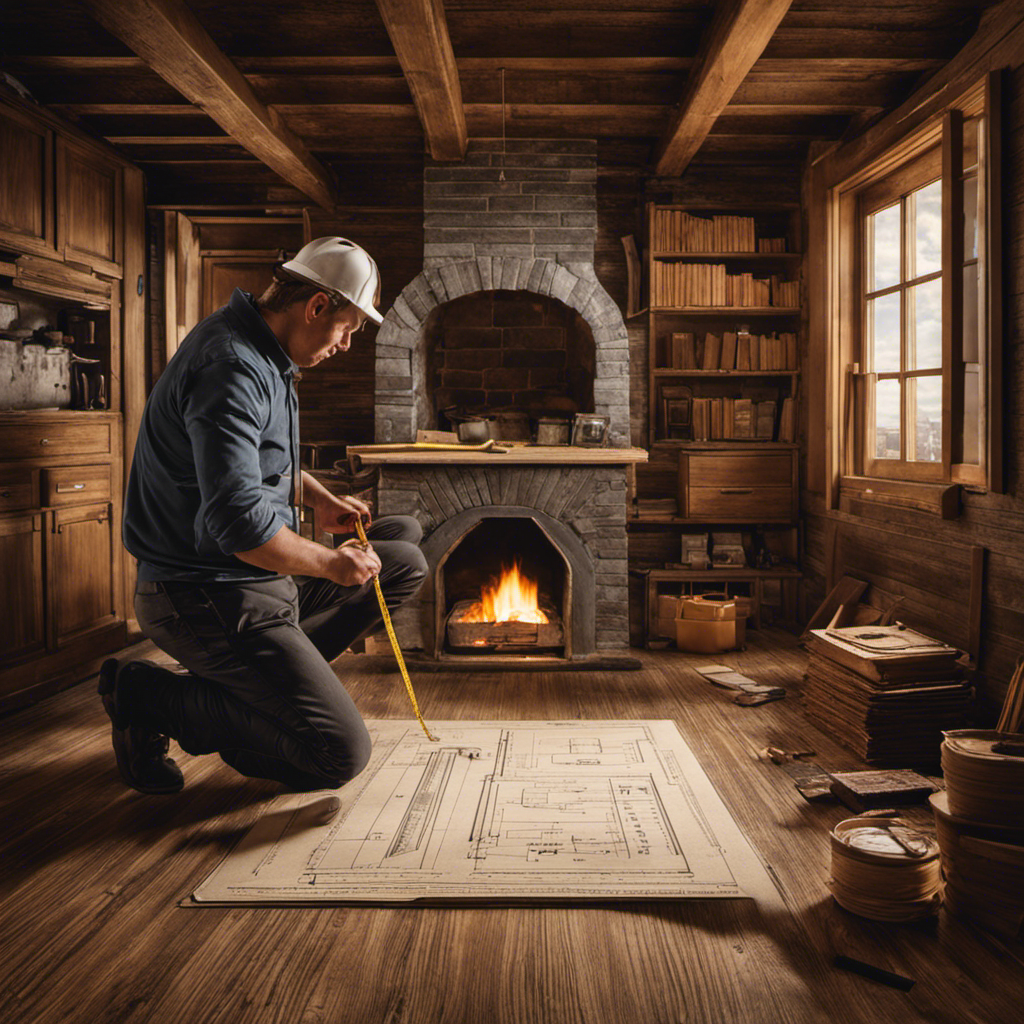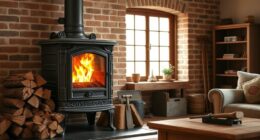As someone with expertise in maintaining wood stoves, I understand how annoying it is when a room fills with smoke due to increasing wind speeds. However, don’t worry! In this article, we’ll cover the reasons why wood stoves are prone to smoking during windy conditions and offer effective solutions.
From proper ventilation techniques to common mistakes to avoid, I’ll equip you with effective strategies to control smoke and maximize efficiency.
Say goodbye to smoke-filled rooms and hello to a cozy, problem-free wood stove experience.
Key Takeaways
- Proper chimney height is crucial in preventing smoke issues during windy conditions.
- Good ventilation and airflow help minimize smoke when the wind blows.
- Common mistakes such as overlooking chimney height and poor stovepipe joint seals contribute to smoke problems.
- Techniques like adjusting the damper, using a draft stopper, and installing windbreaks can control smoke and maximize efficiency in windy weather.
Understanding the Factors That Cause Wood Stoves to Smoke in Windy Conditions
I think understanding the factors that cause wood stoves to smoke in windy conditions is important. When the wind blows, it can disrupt the airflow in and around the wood stove, leading to smoke escaping into the room.
One of the main causes of wood stove smoke in windy conditions is a lack of proper chimney height. If the chimney is too short, the wind can create a downdraft, pushing the smoke back into the house.
Another factor is the location of the wood stove. If it’s placed too close to a window or door, the wind can blow directly into the stove, causing it to smoke.
To prevent wood stove smoke in windy weather, it’s crucial to ensure that the chimney is tall enough and the stove is positioned properly. This will help minimize the effects of wind on the stove’s performance and prevent smoke from entering the room.
Proper ventilation: the key to minimizing smoke when the wind blows.
Proper Ventilation: The Key to Minimizing Smoke When the Wind Blows
Proper ventilation is crucial for minimizing smoke when there’s strong wind. When it comes to wood stoves, maximizing airflow is essential to prevent smoke from being blown back into your living space. One important factor to consider is the proper chimney height.
A chimney that’s too short can result in poor draft and increased smoke. The height of the chimney should be sufficient to ensure that the smoke is carried away by the wind. According to experts, the chimney should extend at least three feet above the highest point of the roof. This allows for better air circulation and prevents the wind from causing smoke to be blown back into the house.
Common Mistakes That Contribute to Smoke Issues in Wood Stoves During Windy Weather
One mistake I made wasn’t considering the height of my chimney, which resulted in increased smoke and poor draft during windy weather. This is a common mistake that many people overlook when installing a wood stove.
The height of the chimney plays a crucial role in ensuring proper ventilation and minimizing smoke issues. A chimney that’s too short can cause backdraft, where the wind blows down the chimney and pushes smoke back into the house. To avoid this, it’s important to follow the recommended guidelines for chimney height based on the stove’s manufacturer specifications.
Additionally, another common mistake isn’t properly sealing the stovepipe joints. Leaks in the joints can allow smoke to escape into the room, causing poor air quality and potential health risks. To prevent this, it’s important to use high-quality stovepipe sealant and ensure a tight seal between the sections of pipe.
Effective Techniques for Controlling Smoke and Maximizing Efficiency in Windy Conditions
During windy conditions, I found that adjusting the damper settings on my stove helped control smoke and maximize efficiency. Here are four effective techniques for controlling draft and reducing smoke issues caused by wind direction impact:
-
Adjust the damper: By opening the damper slightly, you can increase the airflow and prevent smoke from escaping into the room. Conversely, closing the damper can restrict airflow and reduce smoke production.
-
Use a draft stopper: Placing a draft stopper in the stovepipe can prevent wind from entering the stove and causing smoke issues. This simple yet effective solution helps maintain a steady draft and improves combustion efficiency.
-
Create a windbreak: Installing a windbreak around the stove can shield it from strong gusts of wind. This can significantly reduce the impact of wind direction on the stove’s performance and minimize smoke problems.
-
Check the chimney height: Ensuring that your chimney extends above nearby obstacles, such as trees or buildings, can help prevent wind interference. A taller chimney promotes better draft and reduces the likelihood of smoke issues during windy conditions.
Installing Windbreaks and Other Exterior Solutions to Reduce Smoke From Wood Stoves
I have found that installing a windbreak around my stove can greatly reduce the amount of smoke that enters my home. Wind deflectors, such as a strategically placed fence or other barriers, help redirect the wind away from the stove’s chimney, preventing it from blowing smoke back into the house.
These windbreaks create a more stable environment around the stove, allowing for better combustion and reducing the chances of smoke backdrafts.
Additionally, chimney extensions can be used to increase the height of the chimney, helping to improve the draft and prevent smoke from being pushed back into the house by strong winds.
Frequently Asked Questions
How Does Wind Affect the Performance of a Wood Stove?
When wind blows, it can impact the efficiency and combustion of a wood stove. The airflow from the wind can disrupt the draft, causing smoke to back up into the room.
Can the Type of Wood Used in a Wood Stove Affect the Amount of Smoke Produced in Windy Conditions?
The type of wood used in a wood stove can indeed impact the amount of smoke produced in windy conditions. Wind can affect the performance of the stove, leading to increased smoke emissions with certain wood types.
Are There Any Specific Maintenance Tasks That Should Be Done to Prevent Smoke Issues in Wood Stoves During Windy Weather?
Preventive maintenance and troubleshooting tips can help prevent smoke issues in wood stoves during windy weather. Regularly inspecting and cleaning the chimney, ensuring proper airflow, and using wind baffles can all improve stove performance in these conditions.
Is There a Specific Temperature Range That Is More Prone to Causing Smoke Issues in Wood Stoves During Windy Conditions?
The temperature range can influence smoke issues in wood stoves during windy conditions. Understanding how wind affects combustion and draft can help identify the optimal temperature range to prevent smoke problems.
Are There Any Health Risks Associated With Wood Stove Smoke in Windy Conditions?
In windy conditions, wood stove smoke can pose health risks and have negative environmental impacts. Studies show that exposure to wood smoke can lead to respiratory issues and increased risk of heart disease.
Conclusion
In conclusion, understanding the factors that cause wood stoves to smoke in windy conditions is crucial for minimizing smoke issues.
Proper ventilation is key in ensuring efficient burning and reducing smoke. Avoiding common mistakes and implementing effective techniques can further control smoke and maximize efficiency.
Additionally, installing windbreaks and other exterior solutions can significantly reduce smoke emission from wood stoves. By implementing these strategies, homeowners can enjoy a smoke-free environment even when the wind blows.
Growing up surrounded by the vast beauty of nature, Sierra was always drawn to the call of the wild. While others sought the comfort of the familiar, she ventured out, embracing the unpredictable and finding stories in the heartbeat of nature.
At the epicenter of every remarkable venture lies a dynamic team—a fusion of diverse talents, visions, and passions. The essence of Best Small Wood Stoves is crafted and refined by such a trio: Sierra, Logan, and Terra. Their collective expertise has transformed the platform into a leading authority on small wood stoves, radiating warmth and knowledge in equal measure.











